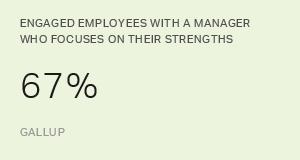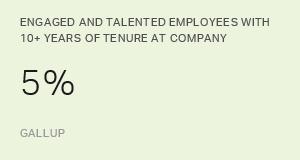Story Highlights
- Managing people you may have to fire is painful
- Leaders must support managers just as they support workers
When factories in America's Rust Belt started shutting down years ago, thousands of people were thrown out of work, towns and communities fell apart, and people's lives were ruined.
But the story of the Rust Belt has played out in communities all over the country. No industry and no place is immune to economic uncertainty. More U.S. companies shut down every year than start up, and the current upswing in mergers and acquisitions will almost certainly lead to layoffs. Inevitably, managers are going to be forced to choose which people to fire.
Good managers -- the kind who care about their people, who've worked hard to develop them -- are going to feel this deeply, with a negative effect on their own engagement. That can hurt whole companies: High-performing managers are the ones that businesses need most, especially when the going gets rough.
Leaders can help those managers get through it with grace and human dignity as they work to keep productivity and performance up. Or leaders can make a bad situation worse. It all depends on the tools they're able to give managers to navigate a layoff.
One of the most powerful of those tools is employee engagement. Unexpected? Sure, but when livelihoods are threatened, disengagement explodes.
But the core elements of engagement -- managerial care and worker development -- are a guide for action, a means of sustaining employee performance, and an opportunity to engender hope in scared workers. All of which are some of the hardest, but most important things leaders and managers can do in difficult times.
Focus on Well-Being and Engagement
Employee engagement is born from people's psychological and emotional attachment to their workplace, and it's going to take a hit during a layoff. Yet, managers still have to keep productivity up. One way to maintain productivity and engagement during difficult times is by focusing on employee well-being.
When layoffs are on the horizon, every aspect of well-being -- financial, physical, community, purpose and social -- is destabilized. Obviously, that's stressful and so is being disengaged. A Gallup-Sharecare study found that disengaged workers reported greater psychological stress, had higher levels of cortisol (the stress hormone linked to heart disease), had on average 2.17 self-reported "unhealthy days" a month compared with 1.25 unhealthy days per month for engaged employees, and more physical pain.
Managers can help employees combat disengagement by putting their every accomplishment on the table, and articulating how the person positively affects the company. People who know or suspect they'll be out of work soon are thinking about resumes and job applications. Highlighting a worker's value reminds people that, if things go south, they truly have something to offer a hiring manager. Realistic hope and a path toward the future can shore up workers' faltering sense of financial and purpose well-being.
But managers can impact employees' physical and social well-being, too.
People who are eating their feelings don't need a lecture on the importance of a well-balanced meal. But they could use a walk. Round up a worker or two at lunch or break time -- venturing outside for a walk-and-talk will burn some calories and some angst, and it reinforces workplace relationships. That can increase employees' physical and social well-being at the same time and the manager's too.
And if leaders can spare the time, they should come along. That demonstrates leadership's concern, sustains workers' engagement and takes some of the pressure off managers. Managers' workloads expand during a layoff -- besides keeping productivity up and the workday moving, managers must do a great deal of emotional labor -- and their well-being may be wobbly, too.
So, a walk will help people get through the day -- but managers and leaders can be instrumental in guiding scared workers into the future as well.
Focus Forward
During layoffs, the future looks pretty bleak to employees. Leaders and managers should do anything they can to prove there is a future worth having.
Leaders can provide outplacement services or invite job recruiters to set up tables in the lobby, uncomfortable as that may feel. Leaders can clear space for local colleges to display continuing education opportunities, or consider and make it known that they've contributed to scholarship funds for reskilling or upskilling current workers.
And leaders should recognize the power of a letter of recommendation. Those letters are more than a resume amplifier, they're a talisman of self-worth. That recognition and validation can light the path toward a future that job seekers can't always clearly see on the outset.
Managers can show people job recruitment websites in their field, or educational and scholarship opportunities that fit the person and his or her career plans. Managers know better than anyone what other managers look for in a given industry and can give each person a list of qualifications to put on their resumes when the time comes.
Be Honest
But one thing leaders and managers must never do is lie.
Leaders don't want to create unnecessary panic, but managers need the truth and so do employees. When managers tell anxious teams that they don't know what to expect, employees assume the manager's lying, which destroys trust -- or employees fear she's already been cut out of the loop and everyone's days are numbered.
Leaders have to give managers up-to-date information, even if nothing has been decided. Managers can only quell fear if they can say, "Don't worry yet. I'll tell you everything I know as soon as I know it." And, "If it comes to it, I'll help you in your next steps."
But managers can only say that, and say it believably, if leaders are honest with managers and managers are honest with employees.
Show You Care
Perhaps the most important thing leaders and managers can do is show they care. At least half of Gallup's Q12 relates to care.
So, yes, managers should talk honestly -- but they must listen, too. Doing so will certainly involve managers in some sad, angry or fearful conversations. Just listening without judgment shows care. Promoting well-being shows care. Helping people move to a better future is the most caring thing of all.
Letting people go with dignity, self-worth and hope for the future takes energy and forethought, and it can be hard. Leaders can help by providing the tools managers need so that people can leave with a sense of personal worth.
And all of these things leaders and managers do for anxious workers? Leaders absolutely have to do them for managers, too.
Show you care. Prove that if there's no future here, there's a future elsewhere and the company will help managers find it. Acknowledge the burden managers endure. If the managers on your team are good, having to fire people they've cared for and developed might be one of the hardest things they ever do. Managers, like anyone else, need to know their own bosses care about them.
Managers can be tempted to sugarcoat the situation or cheer people up with positive platitudes. Don't. It's better to acknowledge the situation for what it is. Of course leaders and managers want to be the heroes and fix everything and save all the jobs. They rarely can.
But they can help sustain well-being, transition people with dignity and provide emotional support. That may be the least of what they want to do, but it's often the best thing they can do.
Discover the best tools for leaders and managers to respond to the new workplace realities:
- Download our free State of the American Manager report to discover what the best managers do differently.
- Download our perspective paper, Get the Most Out of Your Culture, to sustain a great culture during a time of change.
- Understand how your employees are feeling about the change by asking, with Workforce Analytics.




